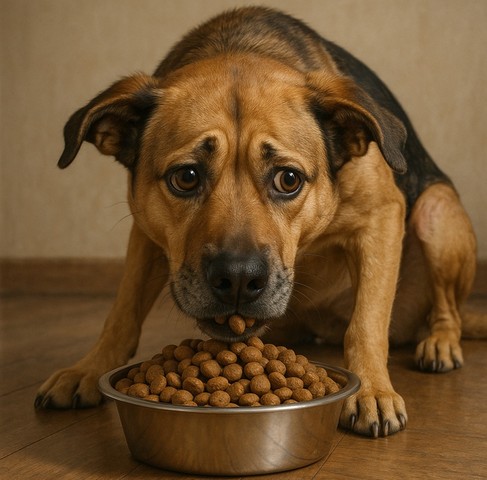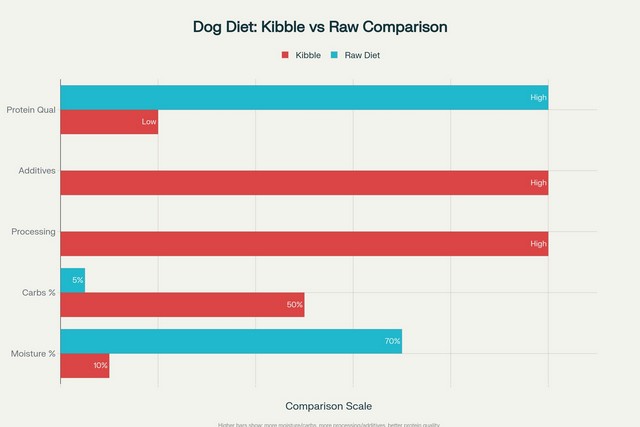If you are a dog owner, you may be concerned about the food you serve it. And one of the most popular dog foods that we make our beloved dogs consume is Kibble food. In view of the recent inputs and research, Kibble food for dogs has come under scrutiny. So, is Kibble good for your dog? Can kibble make a dog sick? Let us try finding answers to those questions.

Quick Answer –
If you wonder if kibble can kill dogs, yes – it can. Kibble food generally consists of flavor enhancers and synthetic nutrients added to it. This can cause severe issues in your dog as the digestive system of dogs is NOT designed for the kind of nutrients available in kibble. It may also contain carcinogens which may be dangerous for your dog’s long-term health.
What is Kibble and How is it Made?
Kibble is the dry dog food that we serve our dogs with. The kibble food is inclusive of all the dry food that is packed with the ingredients and nutrients that your dog needs. By definition, kibble is a commercially manufactured dog food that is in dry food form.
Kibble is a commercially manufactured dry dog food produced by mixing ground meats, vegetables, grains, and synthetic vitamins/minerals into a uniform dough that’s forced through an extruder under high heat and pressure (120–150 °C) to gelatinize starches, sterilize pathogens, and shape the final pellets. After extrusion, kibbles are coated with fats, flavourings, and colourants to restore palatability and mask nutritional losses.

What is Kibble dog food made of? The dry dog food, or kibble, is made from the ingredients that your dog needs in a process called food extrusion. Raw meats, vegetables, carbs, and fillers are some of the ingredients that go into it. The primary ingredients in the kibble include meat, fat, grains and concentrated minerals and vitamins.
-
Up to 40% of vitamins and minerals can degrade during high-heat extrusion, according to a report on Ollie.
-
Starch gelatinization makes carbs digestible but strips native antioxidants.
-
Flavour enhancers and synthetic fortifiers mask nutrient depletion.
How is kibble made? When the ingredients that WWE just talked about come to the manufacturer, they are turned into a coarse powder and mixed together. Starch in the form of rice, potatoes or or lentils is added to them. The starch is used for binding all the food items together. The powdered food is then mixed with waste animal tissues. They together go through the rendering process, wherein the food is cooked to prepare what is known as meat meal. This mix is now placed into an expander and the whole mix goes through the process called extrusion. Extrusion is a highly aggressive process and removes practically every nutrient from the so called pet food. Once done, these pellets are flavoured by adding fat, coloring and flavoring.
Why Kibble is Bad for Dogs – 5 Reasons that Make Kibble Bad for Your Dog
Kibble food for dogs comes with several issues. To begin with, Kibble contains substandard ingredients. Most of the ingredients, such as chicken and meat, is sourced from non-slaughtered sources. Which means the meat or chicken is generally sourced from dead animals. Isn’t that scary? If you really love your furry friend, would you want to serve him that kind of food, ever?
Some of the reasons I stopped feeding my dog with kibble food were due to the following issues I found with it –
1. The quality of the ingredients is substandard
Pet food ingredients are generally sourced for diseased animals. I am sure you are aware of the difference between healthy animals and diseased animals. The ingredients go through a process called rendering, which supposedly sanitises the meat and removes harmful bacteria from it. But, will we eat putrid chicken even when it is “rendered” or purified? Why should our dogs eat it?
According to a report on Veterinary Secrets, many Kibble brands have heavy metal concentrations and PFCs. These can be severely harmful for your pet.
Kibble food is also known to cause cancer in dogs. Feeding kibble can be quite equivalent to killing your dog. It has also been stated to cause liver disease in dogs.
2. It consists of highly processed ingredients
Highly processed foods are generally left with no nutrients. The high heat used during the food extrusion and rendering can leave the food with nothin good for your dog. What your dog (or even you) find intriguing and attractive is the result of flavor enhancers and synthetic nutrients. The types of acrylamide and other carcinogens contained in the dog food can be dangerous to the dog food.
Many kibble formations come with acrylamide, which is highly carcinogenic in cats and dogs. Lifetime expsure to these elements can increase the risk of cancer.
3. High starch content
Kibble food also consists of grains and other high-starch components. They are highly glycemic in nature. Dogs do not need carbohydrates, and a high degree of carbohydrates found in the kibble can make it detrimental to the health of your dog. It can cause insulin, glucagon and cortisol spikes in your dog. The high carb content can also cause pet obesity.
Dogs do not need that many carbs. In contrast, they need protein, which most of the kibble brands lack. As per research published in Dino, a high level of starch can make the dogs have issues with the pancreas.
4. Low moisture is a concern
Kibble food contains a very low level of moisture. It can leave your dog dehydrated for long. It can subsequently result in lethargy, low energy levels, panting and dry nose or eyes. This can result in your dog facing dehydration and wanting to drink much water. Chronic low water intake can lead to urinary issues, lethargy, and dry mucous membranes, says a report in Raw Bistro Blog.
5. Added Chemicals and Colours
The Kibble food contains colours that may be harmful. In fact, many food colors have been banned in developed countries. In fact, food colours have been considered to be a rainbow risks in a recent study. These dyes can even cause health issues such as cancer and hypersensitivity.
Synthetic dyes (e.g., FD&C Red 40, Yellow 5) serve no nutritional purpose and may trigger allergies or hypersensitivity reactions. Although FDA-approved, these petroleum-derived colorants have been linked to behavioral changes and carcinogenic contaminants in independent studies, according to a report on Dogs Naturally.
What should your Dog eat instead of Kibble?
The right food for dogs would be to serve fresh and whole foods. It is advisable too go with the human-grade ingredients. Feeding as much organic food as possible would be a good option. The optimal food for your dog should include healthy fats, high moisture (around 70%). It should also consist of protein, carbohydrates and other nutrients.
-
Cleaner Teeth: Chewing raw bones reduces plaque and tartar
-
Consistent Energy: Low glycemic load prevents sugar spikes.
-
Smaller Stools: Higher digestibility decreases waste volume.
It’s a good idea to explore the myths about pet food before planning the right food for your dog.
The best way is to serve raw food. The raw diet generally consists of organ meats, muscle meat, whole or ground bone, raw eggs, dog-safe fresh fruits and vegetables, and a dairy product such as yoghurt. You will find it offering several benefits that include shiny coats, healthy skin, better dental health, increased energy, and consistent stools.
Can Kibble Food cause Allergies?
There are reports that dogs can face allergic reactions due to kibble food. Primary sources of food in kibble are chickens and beef. They have been identified as the major allergens in most of cases. If you find your dog consistently scratching itself or feeling itchy all of a sudden, it can be an indicator that it has suffered an few allergic reactions.
Some of the allergies that kibble food can cause in dogs include
- Itchy skin
- Skin infection
- Ear infection
- Poor coats
- Weight loss and
- Dirrhoea
High-carb Content in Kibble Food can Cause Gut issues
Kibble food comes with several issues. Some of them may include overprocessing, low-quality ingredients and high carbs with little protein. But, the starch and carbs in the kibble food are what would result in severe gut and digestive issues in your dog. A dog’s intestines are not made for high-carb food, and kibble food consists of a high-carb level.

Kibble can also increase the pH level in a dog’s stomach. This is another reason that can upset your dog’s stomach. A dog’s stomach has one of the lowest pH levels, and it is essential to maintain the levels for optimum health. But, kibble food can increase these levels. It can also cause leaky gut syndrome.
In Conclusion
Kibble is perhaps one of the most commonly used foods that dog owners rely upon. But, it should be noted that kibble food is never the best food item you should feed your dog. It is quite bland, and in addition, it comes with several issues. The processed nature of the food is known to result in allergies, dehydration and several other problems in your beloved dog.
FAQs
Can a dog survive on kibble?
Dogs can live on kibble food. But, from a health point of view, the dog gut is not made for dry food. It is advisable to feed them with raw food, and with human ingredients to be precise. The kibble food has no nutritional value. Most of the ingredients in kibble food are bland and serve no nutritional purpose. Moreover, they can also cause dehydration issues.
What is dog kibble made of?
Kibble food is generally made from meat, grains, legumes, vegetables, and fruits. The food items are mixed, powdered and rendered. Then they go through a process called extrusion to remove moisture in them.
Is kibble hard to digest?
Kibble food is completely bland and can be easily digested. However, it does not serve many nutritional purposes. That is one of the reasons raw food advocates suggest not using kibble food as the staple diet for your dogs.




Add Comment